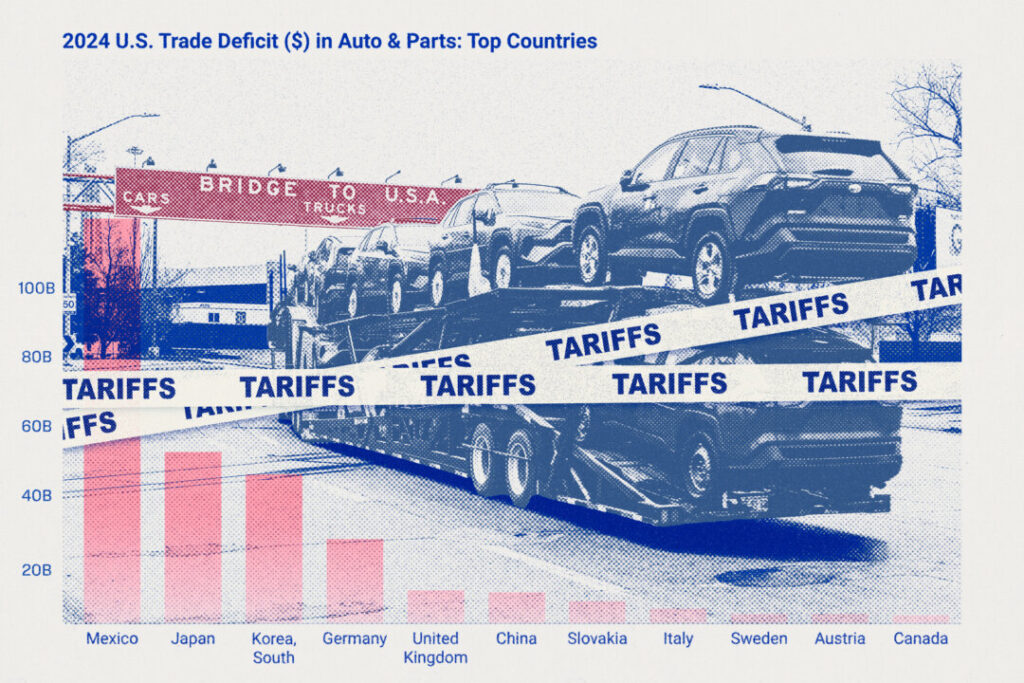The US trade deficit hit a record high of more than $1.2 trillion in 2024. Cars and parts make up nearly a quarter of that.
Tariffs are set to take effect on April 2nd after determining individual tariff rates for each country.
The US automaker has been on a roller coaster since Trump announced a universal 25% tariff on Canadian and Mexican imports in February.
When announcing the exemption, White House spokesman Caroline Leavitt said the president hopes the car maker will move production to the United States.
“He said they should get on it, start investing, start moving, and shift production here to the United States, where they wouldn’t pay tariffs,” she said on March 5.
How did the US come here?
At the heart of the US chronic trade deficit is countless companies that have moved US manufacturing outside the US, according to Yao Yuan Yeh, an international research professor at St. Thomas University in Houston.
When an overseas company ships ships to sell manufactured goods in the United States, such imports usually result in a net trade deficit, as the value of the purchased goods is far greater than what is being sold.
Let’s take an example of the automotive industry.

The truck will transport new vehicles to Richmond, California on March 4th, 2025. US tariffs on imports from Mexico, China and Canada came into effect on the same day. Justin Sullivan/Getty Images
As a result, an imbalance between domestic and foreign investments appears in the tally of trade deficits.
Almost half of the negative balance of the automotive industry trade comes from Mexico ($117 billion), followed by Japan ($50 billion) and South Korea ($43 billion). China ranked sixth in the automotive trade surplus and the US with $9 billion, while Canada ranked 11th in the $2 billion.
Some economists say the trade deficit is a good thing. In their view, it reflects a strong economy and robust spending. Furthermore, if the US reduces its negative trade balance, it could slow global economic growth.
Yeh said he was aware of how the world should develop the problem. From a globalization perspective, the free market is highly developed. Therefore, outsourcing production to countries with cheap labor is a matter of high efficiency and divides the roles and responsibilities of countries.
In the 1990s, the idea of companies that utilized global resources led the US to promote the establishment of the World Trade Organization and sign free trade agreements, including the North American Free Trade Agreement (NAFTA).
Yeh said during the Epoch era that for people working in manufacturing, the trade deficits were directly linked to losing jobs to people overseas, and “had a huge loss to the majority of workers in most developed countries.”
Since 1994, the first year of NAFTA, annual car production in Mexico has increased from 1.1 million units last year to around 4 million units. Last year it exported about 3 million units, or 80% of production, to the United States.
“The tariffs are an attempt to stop bleeding from work in the United States for the past 33 years,” Fein said. “Taxes are not the final solution, but it’s a big factor in fixing this issue.”
The End of Playing Game
The one-month tariff is not sufficient to significantly change the supply chain by waiving automakers from being tolerant of the White House granted.
But they were able to use this time to develop reliable plans to increase domestic manufacturing, says William Lee, chief economist at the Milken Institute, a California economic think tank.
He said automakers can negotiate that they will pay tariffs on net cross-border transactions resulting from multiple imports and exports, or that they will obtain extensions or permanent tariff relief when expanding domestic production.
Lee said the increase in domestic production is the main purpose of the White House, whether or not it will achieve its goal by returning foreign production to its homeland or expanding domestic production.

On February 19, 2025, new canned beer cans will be moved along the assembly line at the Can Van headquarters in Sacramento, California. Craft Brewers is spoofing a 25% tariff on aluminum imports, and is expected to take effect under President Donald Trump on March 12th. Justin Sullivan/Getty Images
Tariffs are elements of Trump’s three planning plans to grow the US economy, Lee said.
“We’ll cut taxes to reduce the size of government,” he told the Epoch era, adding that the first factor would also help to move the workforce into the private sector.
“The second is to cut regulations and use tariffs as an incentive to produce in the US rather than overseas,” he said.
“At the same time, we will protect domestic producers,” Lee said of the use of tariffs to level the arena by increasing the prices of foreign goods.
Yeh said Trump’s final game with tariffs is to give the US a more advantageous position in the world and make America more self-sufficient. Given the four-year limit, Yeh said it would be more realistic for Trump to set direction and build momentum.
“Taxes are a tool to open the door to negotiation,” Yeh said. “The goal is to increase investment in the US or increase foreign purchases of American products.”
There are some early signs of momentum, and businesses are investing more in the US to avoid tariffs.
After Trump took office, Stellantis, a multinational automaker that owns Chrysler and other brands, confirmed plans to reopen its assembly plant in Belvidere, Illinois, and build an updated Midsize SUV model in Detroit.
Earlier this month, Honda said it plans to create an updated sedan model in Indiana rather than Mexico.
“This investment is a clear demonstration that tariffs will work very strongly,” Trump added that more will be announced in a few days, including the car mandate.

